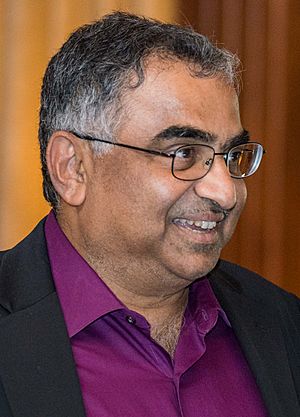Shrinivas Kulkarni facts for kids
Quick facts for kids
Shrinivas Kulkarni
|
|
|---|---|

Kulkarni in 2016
|
|
| Born | 4 October 1956 Kurundwad, Maharashtra, India
|
| Alma mater |
|
| Awards |
|
| Scientific career | |
| Fields | Astronomy
|
| Institutions | California Institute of Technology |
| Doctoral advisor |
|
| Notable students | Alicia M. Soderberg |
Shrinivas Ramchandra Kulkarni (born October 4, 1956) is a famous astronomer. He was born in India and now works in the United States. He is a professor of astronomy and planetary science at the California Institute of Technology (Caltech). He used to be the director of the Caltech Optical Observatory. This observatory oversees large telescopes like Palomar and Keck. Kulkarni has received many important awards for his work in astronomy.
Contents
Early Life and Education
Shrinivas Ramchandra Kulkarni was born on October 4, 1956. He grew up in a small town called Kurundwad in Maharashtra, India. His father, Dr. R. H. Kulkarni, was a surgeon. His mother, Vimala Kulkarni, was a homemaker. Shrinivas has three sisters: Sunanda Kulkarni, Sudha Murthy, and Jaishree Deshpande. Sudha Murthy is a well-known educator, author, and helper of others.
Kulkarni and his sisters grew up in Hubballi, Karnataka. They went to local schools there. He earned his master's degree in applied physics in 1978. He studied at the Indian Institute of Technology, Delhi. Later, he received his PhD from the University of California, Berkeley in 1983.
Career in Astronomy
In 1987, Kulkarni became a professor at the California Institute of Technology. He has helped guide many young scientists in their studies. By the end of 2016, he had mentored 64 young scholars.
Kulkarni is known for making important discoveries. These discoveries have opened up new areas of study in astronomy. He uses different types of light waves to observe space. His research covers many exciting topics. These include pulsars, brown dwarfs, and gamma-ray bursts. He has made big contributions to these areas of astronomy.
Important Discoveries
Kulkarni started his career studying radio waves from space. He studied the Milky Way Galaxy using a method called HI absorption. He observed the four arms of our galaxy. His early work with his advisor, Carl Heiles, is still very important in the field.
While he was a student, he discovered the first millisecond pulsar. This pulsar is called PSR B1937+21. He found it with Donald Backer and other colleagues. In 1986, he found the first visible partner of binary pulsars. This was when he was a fellow at Caltech. He also helped discover the first globular cluster pulsar in 1987. He used a supercomputer for this discovery.
Kulkarni and his team showed that soft gamma-ray repeaters are neutron stars. These stars are linked to supernova remnants. This discovery helped scientists understand that neutron stars with very strong magnetic fields, called magnetars, are soft gamma-ray repeaters.
In 1997, a team from Caltech and NRAO, led by Kulkarni, made another big discovery. They showed that gamma-ray bursts come from outside our galaxy. They also found the visible light sources for these bursts. Their research helped start detailed studies of where gamma-ray bursts come from.
Kulkarni was also part of the Caltech team that found the first clear brown dwarf in 1994. This brown dwarf orbited a star called Gliese 229.
His recent work involves the Palomar Transient Factory. This project has found new types of optical transients. These include very bright supernovae and other unique stellar explosions. His success is clear from the many scientific articles he has published. He received the Dan David Prize in 2017 for his contributions to astronomy.
Awards and Recognition
Kulkarni has received many awards and honors. These include the Alan T. Waterman Award in 1992. He also received the Helen B. Warner Prize in 1991. In 2002, he was awarded the Jansky Prize. The Dan David Prize followed in 2017. In 2015, he received an honorary doctorate from Radboud University in the Netherlands. Most recently, in 2024, he was awarded the Shaw Prize in Astronomy.
Contributions to the Field
Kulkarni has also served the scientific community. Since 2009, he has been the head of the jury for the Infosys Prize in Physical Sciences. This prize is given by the Infosys Foundation.
Kulkarni is a member of four important science academies around the world. He became a Fellow of the Royal Society in London in 2001. In 2003, he became a member of the United States National Academy of Sciences. He was made an honorary fellow of the Indian Academy of Sciences in 2012. On September 12, 2016, he became a foreign member of the Royal Netherlands Academy of Arts and Sciences.

